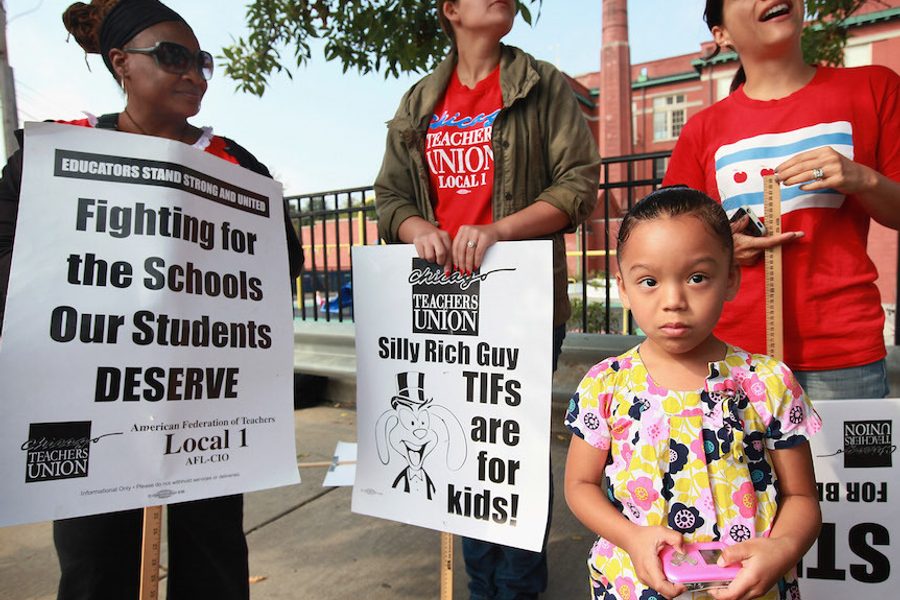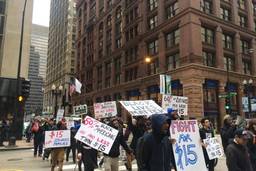
For four months, In These Times has worked with CivicLab’s TIF Illumination Project on a nationwide investigation of tax increment financing (TIFs) — a widespread and little-understood tool to divert public funds to development projects. This is the first in a series of reports.
Late Monday evening, the Chicago Teachers Union (CTU) tweeted that only one thing could avert the citywide strike — its second in four years — scheduled for the next day: “We’re asking for $500/student for resources. Until the mayor decides to provide from TIFs, negotiations continue.”
A few minutes before midnight, CTU President Karen Lewis announced at a press conference that a tentative agreement had been reached and the strike was off. Asked by a reporter whether Mayor Rahm Emanuel had indeed agreed to release tax increment financing, or TIF, funds to the schools, Lewis said with a smile, “Well, it’s not in the contract, but there are rumors…”
It seemed that indeed, the mayor had “decided to provide from TIFs.” Later, a mayoral spokeperson confirmed to WBEZ that Emanuel was releasing $88 million in TIF money to schools, far less than would be needed to fund the CTU’s demand of an additional $500 per pupil.
What are TIFs, and how did this obscure and shadowy public financing tool become central to the battle over the future of Chicago public schools?
On September 29, roughly a month after the city laid off more than 1,000 CPS employees as a cost-cutting measure, the CTU issued a 10-day notice of intent to strike. At issue was money: The city had pledged to cap the CPS budget for fiscal year 2017 at $5.4 billion — a $300 million reduction from the previous year. In addition to the layoffs, the city was pushing for numerous contract concessions to keep costs down, including increased healthcare costs for teachers and cuts to special education services.
The blame game when it comes to public education funding in Chicago is a messy one. City officials claim that Chicago gets the short end of the stick compared to many districts downstate. They have been going back and forth with legislators in Springfield to secure additional funding for fiscal year 2017.
While acknowledging the role of the state, the CTU cites the city’s diversion of funds from schools to “pet projects” as evidence that the city is not broke — but rather, that Mayor Rahm Emanuel simply isn’t prioritizing public school funding.
“Pet projects” is where TIFs enter the picture. TIF districts have a bad reputation in Chicago, and for good reason. On paper, TIFs are a tool for cities to funnel property tax revenue into “blighted” areas that need economic investment. In reality, according to an In These Times/CivicLab investigation, almost half of Chicago TIF money goes toward high-end development in the central business district downtown. Critics argue that many TIF projects, like Mayor Emanuel’s controversial plan to invest $55 million in a basketball arena for DePaul University, serve corporate rather than public interests.
But in these “corporate slush funds,” as opponents call them, progressive city council members saw the potential to invest in Chicago’s schools and resolve the contract negotiations. On July 20, with CTU’s backing,12th Ward Ald. George Cardenas and 10th Ward Ald. Susan Garza proposed the Chicago Public Education Revitalization Ordinance to release TIF surplus money to the schools. Aldermen noted that the mayor could unilaterally do the same with an executive order, if he so chose. On Friday, several parents spoke at city hall, calling on Emanuel and city council to release the TIF funds and prevent a strike.
“When our schools are in a crisis and laying off hundreds of people, it becomes harder and harder to defend a DePaul stadium or a gleaming high-rise downtown,” says CTU Vice President Jesse Sharkey.
The math on TIFs
In Chicago, roughly 53 cents of each dollar in property taxes is earmarked for CPS. But when a TIF district is created, any increases in property tax revenue — from, say, new developments or rising property values — are diverted to the TIF. Schools see no money from that property tax growth; instead, the entire dollar goes toward the TIF project, typically to pay private developers. In These Times found that in 2015 alone, about $177 million that would have gone to CPS was siphoned off by TIFs around the city.
According to Cook County Clerk David Orr, the city declared a $116 million TIF surplus as of July 2016 — money sitting in TIF funds and not committed to any project. There may be even more uncommitted TIF money simply lying around. Orr noted that the city didn’t disclose how it arrived at this figure and “it’s not clear which TIFs contributed to this surplus.” According to an In These Times/CivicLab analysis, the total balance in Chicago TIF accounts at the end of 2015 was more than $1.3 billion.
The Chicago Public Education Revitalization Ordinance mandates that the city transparently calculate the annual TIF surplus, then release the school’s share of the surplus taxes (roughly 53 percent) back to CPS. Cardenas tells In These Times that a new version of the proposal being drafted in committee would devote an additional 20 percent of the TIF surplus to CPS during particularly “distressed” times for the school district.
In addition to being led by the Progressive Reform Caucus, of which Alderwoman Garza is a part, the bill has the support of the CTU and was drafted in consultation with CTU members. Garza has been a CPS employee since 1996 and is a member of the CTU. The union has been calling for the funneling of TIF surplus into the schools since at least 2010.
It all comes down to money
“A lot of the dispute [with CPS] comes down to resources and revenues,” says CTU Vice President Sharkey. “It’s hard to land negotiations with the board when you don’t have a source of revenue.”
Sharkey believes that Board of Education members don’t support layoffs, shrunken programs and poor infrastructure on principle, but are constrained by limited resources. A TIF surplus would grease the wheels for both sides of the negotiations.
Even though the ordinance would create a new stream of funding for schools, the Board of Education did not come out in support. Sharkey believes this is because Chicago’s Board of Education is mayorally appointed, rather than elected as in most cities. “They would rather be politically loyal than to be committed to students,” says Sharkey.
The ordinance “interferes with the mayor’s ability to use TIF funds however he sees fit,” Sharkey says.
Emanuel opposed the ordinance when it was originally introduced over the summer. The Sun-Times reported in August that the mayor teamed up with 47th Ward Ald. Ameya Pawar, one of the sponsors of the ordinance, to draft an alternate TIF surplus policy that would allow aldermen and Emanuel himself discretion in directing TIF surpluses toward CPS.
The logic was that by allowing aldermen to opt out of the ordinance, he’d be doing poorer wards a favor. They’d have the choice of investing in their ward’s economic development instead of contributing to a larger pool of money for schools across the city. Pawar told the Sun-Times, “TIFs located in neighborhoods that really need economic development shouldn’t have to have every dollar surplussed.”
But the CTU and progressive aldermen believe that funding for CPS must be guaranteed. “In theory, [aldermanic discretion] sounds good, but in reality, what you are doing is dividing and conquering,” says Ramirez-Rosa.
“I think that Cardenas/Garza ordinance is good precisely because it takes the discretion out of the hands of the mayor and then puts it into a process that automatically moves money into schools,” agrees Sharkey.
The Sun-Times reported on Monday that, as a result of strike threats and intense last-minute pressure, Mayor Emanuel was willing to “substantially” increase the $32 million dollars he originally allocated in his proposed ordinance. According the WBEZ, Emanuel’s spokesperson Adam Collins confirmed that instead, approximately $88 million in TIF surplus will go toward CPS. This is less than half of the $500 per student that CTU was demanding going into negotiations. With the finance committee scheduled to convene on Wednesday, the status of the more robust ordinance is unclear. It could be the only hope for greater funding for CPS after what Lewis called a “not-perfect” agreement was reached.
Blighted schools?
Redirecting the TIF surplus to schools helps bring TIFs in line with their stated purpose in Illinois: serving “blighted” communities that have historically seen governmental disinvestment. This is part of the logic behind the Cardenas-Garza ordinance, which draws a connection from the language of “blight” “underperformance” and “decay” in TIF policy to the current drained state of Chicago Public Schools.
“CPS is being cut to the bone, and the cuts that have occurred over the last three years have really hurt our children,” says Ramirez-Rosa. “If you look at a city with so much violence, the school system can be a solution to that violence. School should be a place where children can go and feel safe, build relationships with their educators, and flourish. This is why we need to fund our schools.”
One educator who was good at building relationships with students is Xian Barrett, who taught social studies and language arts at Brighton Park Elementary on Chicago’s Southwest side until he lost his job in August as part of the wave of layoffs.
Barrett saw students come to school every day with trauma and mental-health issues from outside of the classroom. “Early on it became clear that my students needed a lot of mental health support that was not available,” Barrett says. “Students in CPS specifically are dealing with the violence of incarceration and deportation, and with parents working long hours.”
In response, he helped start a writing circle for 5th through 8th graders in which students could share their stories and support each other. “What was striking is that students were able to articulate directly that they were getting things out of the [writing circle],” Barrett says. “In particular, they told me pretty explicitly how the power of writing has ‘changed their lives.’ ”
To Barrett, this is the kind of the day-to-day impact that can come from adequate school funding, which allows for well-paid teachers and well-resourced programs. “12-, 13-, 14-year-olds who are hitting rock bottom, who aren’t connecting to anyone — in those moments if you have a teacher and programs and things that allow you to connect with peers and educators, that can be life-changing,” he says. “With more funds, we can keep programs that attract kids to things that give them power to make a better society, rather than to other things in communities that are not as safe.”
Barrett was laid off in August, along with the school’s only counselor. The writing program he created will no longer exist. Releasing TIF funds could preserve such programs and keep educators like Barrett in the schools.
It remains to be seen whether CTU members will accept the tentative deal, which appears to be based far less TIF money than the union had demanded, and what role the ordinance may still play.
But progressive aldermen acknowledge that a TIF surplus is not a cure-all for CPS budget deficits. “We need to be working toward fixing the education funding in Springfield,” says Ald. Ramirez-Rosa. “But until that happens, the city has a responsibility to do what it can to help our kids. We need to prioritize our children over the corporations and businesses that benefit from the use of TIFs.”
This story was made possible by a grant from the Leonard C. Goodman Institute for Investigative Reporting.

I hope you found this article important. Before you leave, I want to ask you to consider supporting our work with a donation. In These Times needs readers like you to help sustain our mission. We don’t depend on—or want—corporate advertising or deep-pocketed billionaires to fund our journalism. We’re supported by you, the reader, so we can focus on covering the issues that matter most to the progressive movement without fear or compromise.
Our work isn’t hidden behind a paywall because of people like you who support our journalism. We want to keep it that way. If you value the work we do and the movements we cover, please consider donating to In These Times.




